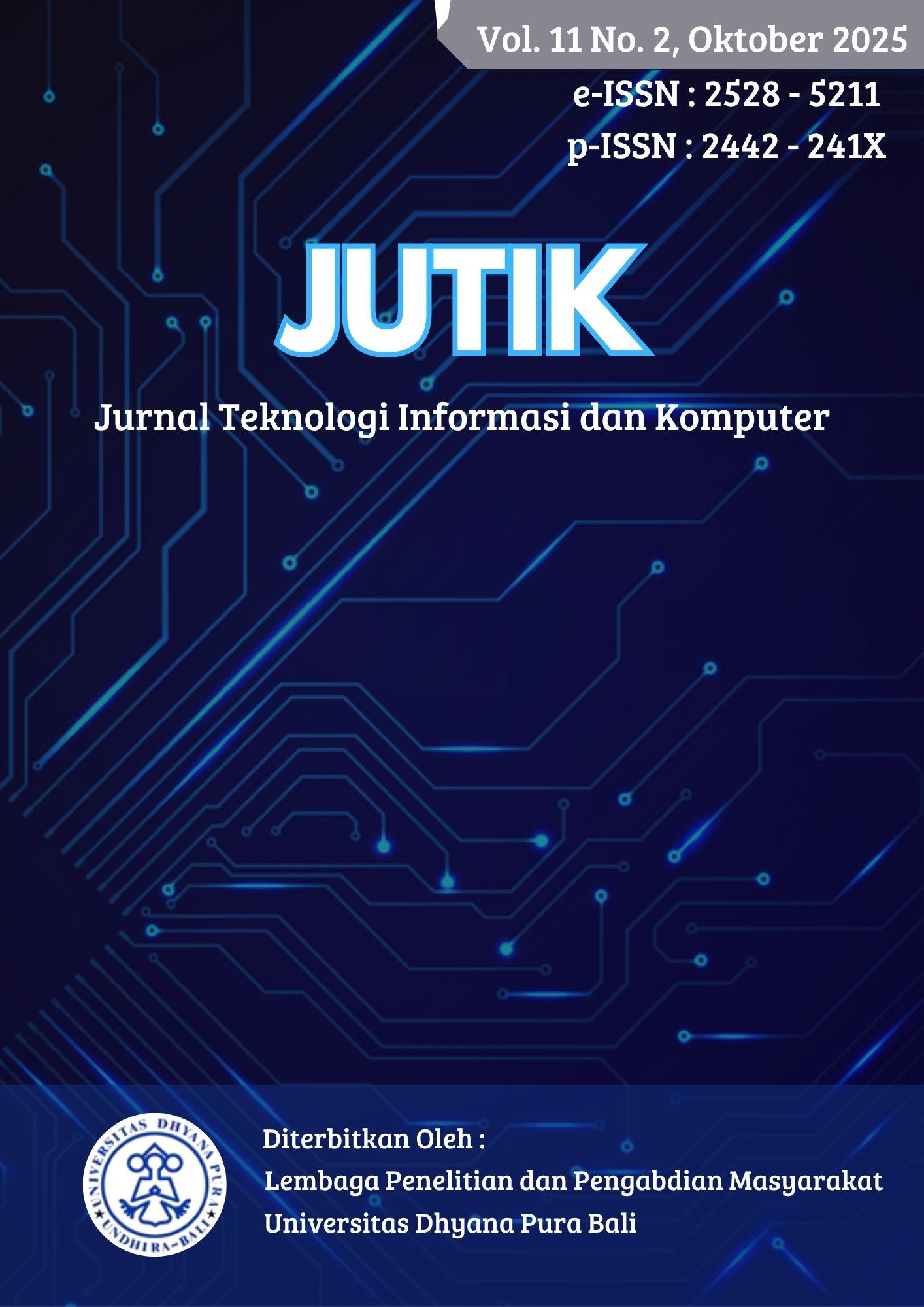OPINI MASYARAKAT TERHADAP BONUS DEMOGRAFI PADA KANAL YOUTUBE DENGAN METODE TF-IDF, NAÏVE BAYES DAN SMOTE
DOI:
https://doi.org/10.36002/jutik.v11i2.3902Keywords:
Demographic Bonus, Naïve Bayes, Public Opinion, Sentiment, TF-IDFAbstract
This study examines public opinion on the demographic bonus issue expressed through comments on YouTube channels using the TF-IDF, Naïve Bayes, and SMOTE methods. The data used consists of 870 comments that have been manually labeled into positive and negative sentiments. The research stages include data pre-processing in the form of case folding, removal of non-alphabetic characters, stopword removal, and stemming, then feature extraction using TF-IDF to convert text into numeric representations that can be processed by the algorithm. This study compares the performance of the Naïve Bayes sentiment classification model in two scenarios, namely without and with the application of SMOTE. The SMOTE technique is used to overcome data imbalance between sentiment classes so that the classification results are more balanced and unbiased. The evaluation results show that the model without SMOTE produces an accuracy of 70% but has a very low recall in the positive class. After applying SMOTE, the accuracy increased to 77%, with the highest precision of 0.89 in the negative class and the highest recall of 0.92 in the positive class. The word cloud visualization shows the dominant words that reflect the pattern of public opinion regarding the demographic bonus clearly and informatively. The results of this study can provide a quantitative picture of public perception and be a consideration for policy makers. In the future, this method can be further developed with other algorithms and data from various social media platforms to improve the accuracy and representativeness of sentiment analysis.
References
[1] N. Satyahadewi, A. Amir, and E. Hendrianto, “Proyeksi Peningkatan Perekonomian melalui Pemanfaatan Bonus Demografi 2040,” Kaganga:Jurnal Pendidikan Sejarah dan Riset Sosial Humaniora, vol. 6, no. 2, pp. 715–725, Dec. 2023, doi: 10.31539/kaganga.v6i2.7943.
[2] D. Irma Aprianti and S. Choirudin, “Tantangan Bonus Demografi Bagi Pemerintah,” Nusantara Innovation Journal, vol. 1, no. 1,2022. doi: 10.70260/nij.v1i1.12.
[3] N. Nurrahmah, C. Zuriana, D. Iskandar, S. Sanusi, A. Armia, and M. Idham, “Opini Publik terhadap Debat Capres 2024: Analisis Sentimen dalam Komentar Live Youtube KPU RI,” Ranah: Jurnal Kajian Bahasa, vol. 13, no. 2, p. 472, Dec. 2024, doi: 10.26499/rnh.v13i2.6063.
[4] B. Wicaksono and V. R. S. Nastiti, “Analisis Sentimen dalam Opini Publik di Chanel Youtube Indonesia Lawyers Club Tentang Isu Populer dengan Menggunakan Metode LSTM dan Bi-LSTM,” Jurnal Algoritma, vol. 21, no. 2, pp. 241–251, Dec. 2024, doi: 10.33364/algoritma/v.21-2.1696.
[5] T. Wijaya, R. Indriati, and M. Muzaki, “Analisis Sentimen Opini Publik Tentang Undang-Undang Cipta Kerja Pada Twitter,” Jambura: Journal of Electrical and Electronics Engineering, vol. 3, pp. 78–83, 2021, doi: 10.37905/jjeee.v3i2.10885.
[6] J. E. Br Sinulingga and H. C. K. Sitorus, “Analisis Sentimen Opini Masyarakat terhadap Film Horor Indonesia Menggunakan Metode SVM dan TF-IDF,” Jurnal Manajemen Informatika (JAMIKA), vol. 14, no. 1, pp. 42–53, Feb. 2024, doi: 10.34010/jamika.v14i1.11946.
[7] R. Wahyu Pratama, P. A. Simanullang, P. T. Hutabarat, R. Dly, and A. Perdana, “Rancang Bangun Website Pengelolaan Buku Digital Berbasis Natural Language Processing (NLP),” JuTIK: Jurnal Teknologi Informasi dan Komputer, vol. 11, no. 1, pp. 102–113, 2025, doi: 10.36002/jutik.v11i1.3755.
[8] Y. Nurtikasari, Syariful Alam, and Teguh Iman Hermanto, “Analisis Sentimen Opini Masyarakat Terhadap Film Pada Platform Twitter Menggunakan Algoritma Naïve Bayes,” INSOLOGI: Jurnal Sains dan Teknologi, vol. 1, no. 4, pp. 411–423, Aug. 2022, doi: 10.55123/insologi.v1i4.770.
[9] A. Syukron, E. Saputro, and P. Widodo, “Penerapan Metode Smote Untuk Mengatasi Ketidakseimbangan Kelas Pada Prediksi Gagal Jantung,” Jurnal Teknologi Informasi dan Terapan (J-TIT, vol. 10, no. 1, pp. 2580–2291, 2023, doi: 10/25047/jtit.v10i1.312.
[10] N. Rahmah, P. Purnawansyah, and F. Umar, “Metode Support Vector Machine Untuk Klasifikasi Data Penyakit Hati Yang Imbalance,” Buletin Sistem Informasi dan Teknologi Islam, vol. 5, no. 1, pp. 55–64, Apr. 2024, doi: 10.33096/busiti.v5i1.2189.
[11] F. D. Adhiatma and A. Qoiriah, “Penerapan Metode TF-IDF dan Deep Neural Network untuk Analisa Sentimen pada Data Ulasan Hotel,” Journal of Informatics and Computer Science, 2022, doi: 10.26740/jinacs.v4n02.p183-193.
[12] E. Poerwandono and J. Perwitosari, “Penerapan Data Mining Untuk Penilaian Kinerja Karyawan Di PT. Riksa Dinar DJaya Menggunakan Metode Naïve Bayes Classification,” Jurnal Sains dan Teknologi, vol. 5, no. 1, p. |pp, 2023, doi: 10.55338/saintek.v5i1.1416.
[13] A. E. Budiman and A. Widjaja, “Analisis Pengaruh Teks Preprocessing Terhadap Deteksi Plagiarisme Pada Dokumen Tugas Akhir,” Jurnal Teknik Informatika dan Sistem Informasi, vol. 6, no. 3, Dec. 2020, doi: 10.28932/jutisi.v6i3.2892.
[14] A. B. Susanto, S. Wiharjo, and T. Liyana, “Analisis Data Minat Customer Produk Dengan Menggunakan Algoritma Naïve Bayes Classifier (Studi Kasus: PT Jellyfish Education Indonesia),” Scientia Sacra: Jurnal Sains, Teknologi dan Masyarakat. 2023. [Online]. Available: http://pijarpemikiran.com/index.php/Scientia
[15] A. Sentia, “Multinomial Naïve Bayes Classifier Untuk Analisis Sentimen Twitter,” 2023. [Online]. Available: https://www.researchgate.net/publication/376730724
[16] B. F. S. Supriyanto and S. Rosalin, “Analisis Sentimen Program Merdeka Belajar dengan Text Analysis Wordcloud & Word Frequency,” Jurnal Minfo Polgan, vol. 12, no. 1, pp. 25–32, Mar. 2023, doi: 10.33395/jmp.v12i1.12312.
[17] S. Clara, D. L. Prianto, R. A. Habsi, E. F. Lumbantobing, dan N. Chamidah, “Implementasi seleksi fitur pada algoritma klasifikasi machine learning untuk prediksi penghasilan pada Adult Income Dataset,” dalam Prosiding Seminar Nasional Teknologi dan Rekayasa (SENAMIKA), 2021. [Online]. Tersedia: https://conference.upnvj.ac.id/index.php/senamika/article/view/1417
Downloads
Published
How to Cite
Issue
Section
License
Copyright (c) 2025 JUTIK : Jurnal Teknologi Informasi dan Komputer

This work is licensed under a Creative Commons Attribution-NonCommercial-ShareAlike 4.0 International License.
![]()
This work is licensed under a Creative Commons Attribution-NonCommercial-ShareAlike 4.0 International License.











